Mastering LinkedIn B2B Marketing for Tech
October 5, 2025
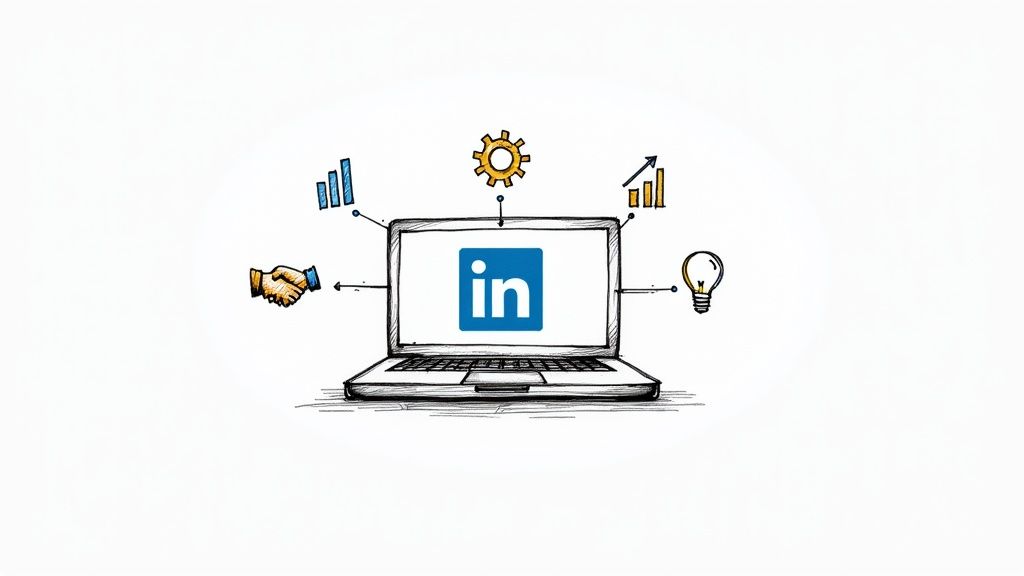
LinkedIn B2B marketing isn't just about posting updates; it's the art of using the platform to connect with professional decision-makers, generate high-quality leads, and build unshakeable brand authority. For B2B SaaS and tech companies, it's the most direct route to an audience that isn't just scrolling—they're actively looking for business solutions.
Why LinkedIn Is Your B2B Growth Engine
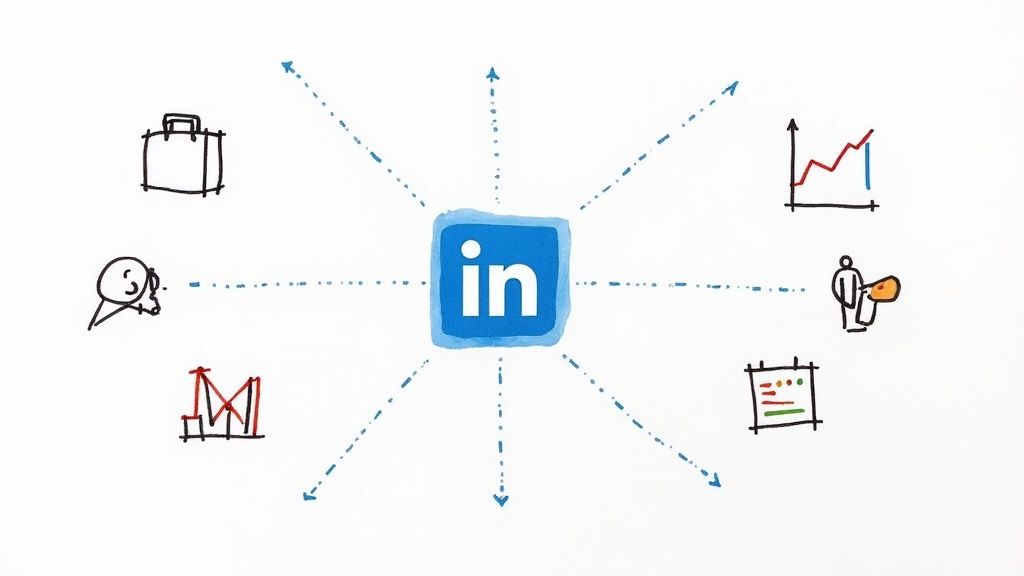
Forget the noise of other social platforms. LinkedIn is where business actually gets done. It's the only major network where people show up in a professional mindset, ready to talk shop, discover new tools, and ultimately, make buying decisions.
That simple fact turns the platform into a goldmine for B2B SaaS and tech startups.
Every connection you make, every comment you leave, every article you share is a chance to engage directly with the executives and technical experts who need what you're selling. The context is everything. On other platforms, you're an interruption; on LinkedIn, you're part of their professional discovery.
A Platform Built for Business Connections
The real power of LinkedIn B2B marketing is baked into its DNA. It was designed from day one to build professional relationships, creating an atmosphere of trust and purpose that you just can't find anywhere else.
This focused environment translates directly into better results. For B2B companies, LinkedIn isn't just another channel to check off the list—it's the main event for building the meaningful connections that actually drive revenue.
"Your LinkedIn presence isn't just a digital brochure; it's your virtual boardroom, your industry conference, and your direct line to the people who can transform your business. Every interaction is an investment in your company's authority."
The Unmatched Power of Professional Targeting
When it comes to targeting, LinkedIn is in a league of its own for B2B. You can zero in on your ideal customer with surgical precision. Think about it—you can target based on:
- Job Title: Want to reach every CTO in the fintech space? You can.
- Industry: Need to get in front of decision-makers in healthcare tech? Easy.
- Company Size: Focusing on scrappy startups or massive enterprise organizations? Done.
- Professional Skills: Looking for developers who list "Python" or "AWS" on their profile? No problem.
This level of specificity means your budget is spent talking to genuinely relevant prospects, not shouting into the void. The data backs this up. LinkedIn is reported to be 277% more effective for lead generation than other major social platforms, and a staggering 80% of its users influence business buying decisions. For a tech startup where every dollar counts, that kind of efficiency is a game-changer.
Ultimately, mastering this platform isn't just a good idea; it's essential for survival and growth. To really dig into how you can turn your LinkedIn presence into a client-acquisition machine, check out this excellent guide: From Lurker to Leader: How to Win High-Value Clients on LinkedIn.
Laying the Foundation: Building a Magnetic Brand Presence
Your LinkedIn Company Page is so much more than a digital business card. For any B2B buyer doing their due diligence, it’s often the very first stop to check if you’re legit.
Think about it from their perspective. An incomplete, sloppy, or inactive page sends a clear signal: carelessness. It quietly suggests your company might be just as disorganized behind the scenes. On the other hand, a sharp, professional, and thoughtfully constructed presence builds immediate trust. It’s your silent brand ambassador, working 24/7.
This isn’t just about filling in boxes in your profile. It’s about building an experience that pulls in your ideal followers, cements you as a credible expert, and starts turning passive visitors into genuinely interested prospects. Every other marketing effort you make on LinkedIn rests on this foundation.
Crafting a Company Page That Actually Converts
Your page should be the central hub of your brand’s story on LinkedIn. Every single element needs to work together to scream, “This is who we help, and these are the problems we solve.” It’s time to transform it from a static brochure into an active, benefit-focused resource.
That tagline? It’s prime real estate. Don't waste it on a generic descriptor like "AI-Powered CRM Software." Instead, spark some interest with a benefit-driven statement. Try something like, "The AI-Powered CRM That Uncovers Hidden Revenue in Your Sales Pipeline." See the difference? One is a feature, the other is a result.
A well-optimized Company Page doesn't just describe what you do; it signals your expertise and professionalism before a prospect ever speaks to your sales team.
Next up, your "About" section. Keep it short, sweet, and all about the customer. A busy decision-maker needs to get your value proposition in seconds. Just answer these three questions clearly:
- What does your company do? Keep it simple. No jargon.
- Who do you help? Be specific about the industries, company sizes, or roles you serve.
- What makes you unique? Get straight to your core differentiator.
For tech companies, strong branding is non-negotiable, and your LinkedIn page is a huge piece of that puzzle. We dive much deeper into this in our detailed guide on building a powerful brand for your tech company.
Your Most Powerful Asset? Your People.
Let's be honest: people connect with other people, not with logos. Your employees are your single greatest untapped marketing resource on LinkedIn, and getting them involved is a core part of any smart LinkedIn B2B marketing strategy.
When your team members—from the CEO down to your lead engineers—have sharp, optimized profiles that reflect the company's mission, it creates an incredible network effect of credibility. Their personal posts and interactions have an authenticity that a company page can never fully replicate.
This doesn't need to be some complicated, top-down program. Start simple. Encourage your team to:
- Align their headlines and bios with the company's value prop.
- Share and comment on company posts, adding their own two cents.
- Jump into relevant industry discussions to show off what they know.
This collaborative approach doesn't just multiply your reach; it humanizes your brand, making you far more relatable and trustworthy to potential clients.
Optimizing Every Detail for Maximum Impact
To really create that magnetic presence, you have to sweat the small stuff. Seemingly minor tweaks can make a huge difference in how your brand is perceived and discovered on the platform.
Here's a quick checklist to make sure your page is pulling its weight. Run through these essentials to tighten up your page and ensure every element is working as hard as it can for you.
Company Page Optimization Checklist
By meticulously dialing in each part of your brand's presence, you create an undeniable sense of professionalism and authority. It’s what pulls your ideal audience in and makes them want to stick around.
Developing a Content Strategy That Connects

Alright, your LinkedIn page is polished and your team is ready to go. Now for the million-dollar question: what do you actually say? Content is the engine of your LinkedIn B2B marketing, and it's what transforms a static company page into a dynamic hub where real relationships are built.
Let's get one thing straight: random product updates and generic company news won't cut it. Your audience—savvy tech buyers and industry leaders—is drowning in noise. They're looking for substance, not sales pitches. They want insights that help them solve a nagging problem, do their job better, or just feel a little bit smarter about the future of their industry.
A killer content strategy on LinkedIn isn’t about shouting into the void. It’s about starting conversations that matter. It's the difference between being just another logo in their feed and becoming a go-to resource they actively seek out.
The Four Pillars of B2B Tech Content
To keep your content mix balanced and compelling, I always advise clients to think in terms of four essential pillars. Each one has a specific job to do, and together they guide your audience from simply being aware of you to becoming a vocal advocate for your brand.
This framework isn't just a nice-to-have; it's a strategic necessity. It keeps your messaging consistent and prevents you from slipping into the all-too-common trap of only posting promotional stuff. It ensures you're always delivering value, which is the only way to build a loyal following on a platform like LinkedIn.
Your content strategy should answer a single question for your audience every day: "Why should I care?" If your post doesn't offer a clear, valuable answer, it's just adding to the noise.
Let’s break down these four pillars and how you can bring them to life.
Pillar 1: Thought Leadership
This is where you earn your stripes and build authority. Thought leadership content has very little to do with your product and everything to do with your unique point of view on the industry. It’s how you prove you understand your customer's world on a profoundly deep level.
- Deep-Dive Articles: Publish long-form articles directly on LinkedIn that tackle a complex, thorny industry challenge. For a cybersecurity SaaS, this could be an article on "The Hidden Costs of API Sprawl in Enterprise Environments."
- Contrarian Takes: Don't be afraid to challenge the status quo. A post titled "Why 'Customer-Centric' Is a Broken Model (And What to Do Instead)" is practically guaranteed to spark a healthy debate and drive engagement.
- Data-Driven Insights: Got interesting data? Use it. Analyze your own proprietary data or find a compelling public dataset and share the key findings. A headline like, "We analyzed 10,000 B2B sales cycles—here’s the #1 reason deals stall," promises immediate, tangible value.
Pillar 2: Practical Product Education
Once you’ve established some authority, you've earned the right to talk about your solution. But this is still not a sales pitch. It’s about educating your audience on how your product solves the very problems you've been discussing in your thought leadership content.
You're connecting the dots for them, showing the practical application of your tool without the hard sell. If you want to go deeper on this, our guide on building a B2B content strategy to boost conversions offers a much more detailed framework.
- Quick "How-To" Videos: Create short, snappy screen-recorded videos (under 90 seconds) that show one powerful feature in action. Think "How to build a custom sales dashboard in under 60 seconds."
- Carousel "Mini-Guides": A carousel post is perfect for walking through a simple 3-step process that your product makes easier. Each slide can be a single step with a clean screenshot and a brief explanation.
- Use-Case Spotlights: Ditch the feature lists and focus on a specific job to be done. Frame it around a pain point: "Struggling with lead routing? Here’s how our platform ensures the right lead gets to the right rep, instantly."
Pillar 3: Authentic Company Culture
People buy from people they know, like, and trust. Peeling back the curtain and showcasing your team and company values is how you humanize your brand. It makes you more relatable and a heck of a lot more attractive to both potential customers and future hires.
- Employee Spotlights: Go beyond a simple headshot. Interview a team member about a project they're passionate about or a challenge they recently crushed for a client.
- Behind-the-Scenes: Share a candid photo or a short video from a team brainstorming session, a company offsite, or even a virtual coffee chat. It’s a simple reminder that there are real, smart people behind the logo.
Pillar 4: Compelling Customer Success
This is your ultimate social proof. Nothing builds trust faster than showing how you've already delivered real, tangible results for companies just like the ones you're trying to reach.
- Quote Graphics: Pull a powerful, punchy one-sentence quote from a customer testimonial and turn it into a clean, branded graphic. It's a quick, high-impact way to share a win.
- Mini Case Studies: Use a carousel to tell a customer's story in 3-5 slides. Keep it simple: The Challenge, The Solution, and The Result (with a hard, quantifiable metric if you have one).
As you map out your content, it always helps to keep an eye on the latest content marketing trends to make sure your approach stays fresh and effective. By consistently balancing these four pillars, you'll create a rich, varied feed that builds authority, educates your market, humanizes your brand, and proves your value time and time again.
You've polished your company page and have a content strategy ready to go. Now it's time to roll up your sleeves and execute. This is the part where strategy meets the real world, and your tactical execution—across both organic and paid channels—is what separates real momentum from just spinning your wheels.
The goal isn't just to be active; it's to be intentionally present where it actually matters.
A killer LinkedIn B2B marketing plan needs to fire on two cylinders. Your organic work builds community, trust, and long-term authority. Think of it as your foundation. Meanwhile, your paid campaigns are the accelerator, giving you that targeted push to speed up lead gen and get in front of hyper-specific decision-makers. When you get them working together, you create a powerful cycle of growth.
Mastering Your Organic Reach
Organic marketing on LinkedIn is a long game, but it’s the most authentic way to build a following that actually cares about what you do. It’s about consistently showing up with value, jumping into conversations, and becoming a genuine part of your industry's community—not just another vendor shouting from the sidelines.
Your organic plan has to be sustainable. It's way better to publish three high-quality, conversation-starting posts a week than to spam the feed with ten low-effort updates that nobody engages with. Consistency crushes frequency, every single time.
Focus on sparking conversations, not just broadcasting messages.
A few practices will make all the difference:
- Meaningful Commenting: Set aside time each day to drop thoughtful comments on posts from industry leaders, prospects, and relevant hashtags. A good comment adds real value to the conversation and subtly positions you as an expert.
- Authentic Group Participation: Find two or three active, high-quality LinkedIn Groups in your niche. Don't just drop links to your blog and run. Answer questions, offer advice, and genuinely engage in discussions to build credibility.
- Proactive Engagement: When someone comments on your company’s post, respond quickly and thoughtfully. This simple act shows you're actually listening and encourages more people to join the conversation.
Demystifying LinkedIn Ads for Tech Startups
While organic builds your foundation, paid advertising gives you control, precision, and speed. For B2B SaaS and tech startups, LinkedIn Ads are a direct line to the exact job titles, industries, and company sizes that make up your ideal customer profile. It’s one of the most efficient ways to get your solution in front of qualified buyers.
The data backs this up. LinkedIn ads can boost purchase intent by a whopping 33%, which is a huge influence on a buyer's final decision. Even better, prospects who see both brand and acquisition ads are six times more likely to convert. For B2B marketers, we often see conversion rates on LinkedIn that are double what we get on other platforms. You can find more stats on LinkedIn's ad effectiveness on Sproutsocial.com.
This surgical approach means even startups with modest budgets can make a real impact, as long as their campaigns are managed with intention. For a deeper dive into crafting effective campaigns, explore our guide on creating a successful B2B advertising strategy.
Choosing the Right Ad Formats
LinkedIn has a whole menu of ad formats, but a few are the real workhorses for B2B tech companies. Knowing which format to use for your specific goal is critical to avoid burning through your budget.
These are the go-to formats for a strong B2B campaign:
- Sponsored Content: These are the native ads that pop up right in the LinkedIn feed. They're perfect for promoting your best content, like a deep-dive blog post, a webinar registration, or a quick case study. They feel less like an ad and are fantastic for building brand awareness and thought leadership.
- Message Ads (Formerly Sponsored InMail): This format lets you send a direct, personalized message straight to your target audience's LinkedIn inbox. Use this one sparingly and only for high-value offers, like an invitation to an exclusive event or a demo for a very specific role. The key is to make it feel personal, not like spam.
- Lead Gen Forms: This isn't a separate ad format, but a feature you can attach to your Sponsored Content. When someone clicks your CTA, a form instantly pops up, pre-filled with their LinkedIn profile info. This slashes the friction and can send your conversion rates for things like ebook downloads or demo requests through the roof.
This simple flow chart breaks down the core steps for getting a successful paid campaign off the ground.
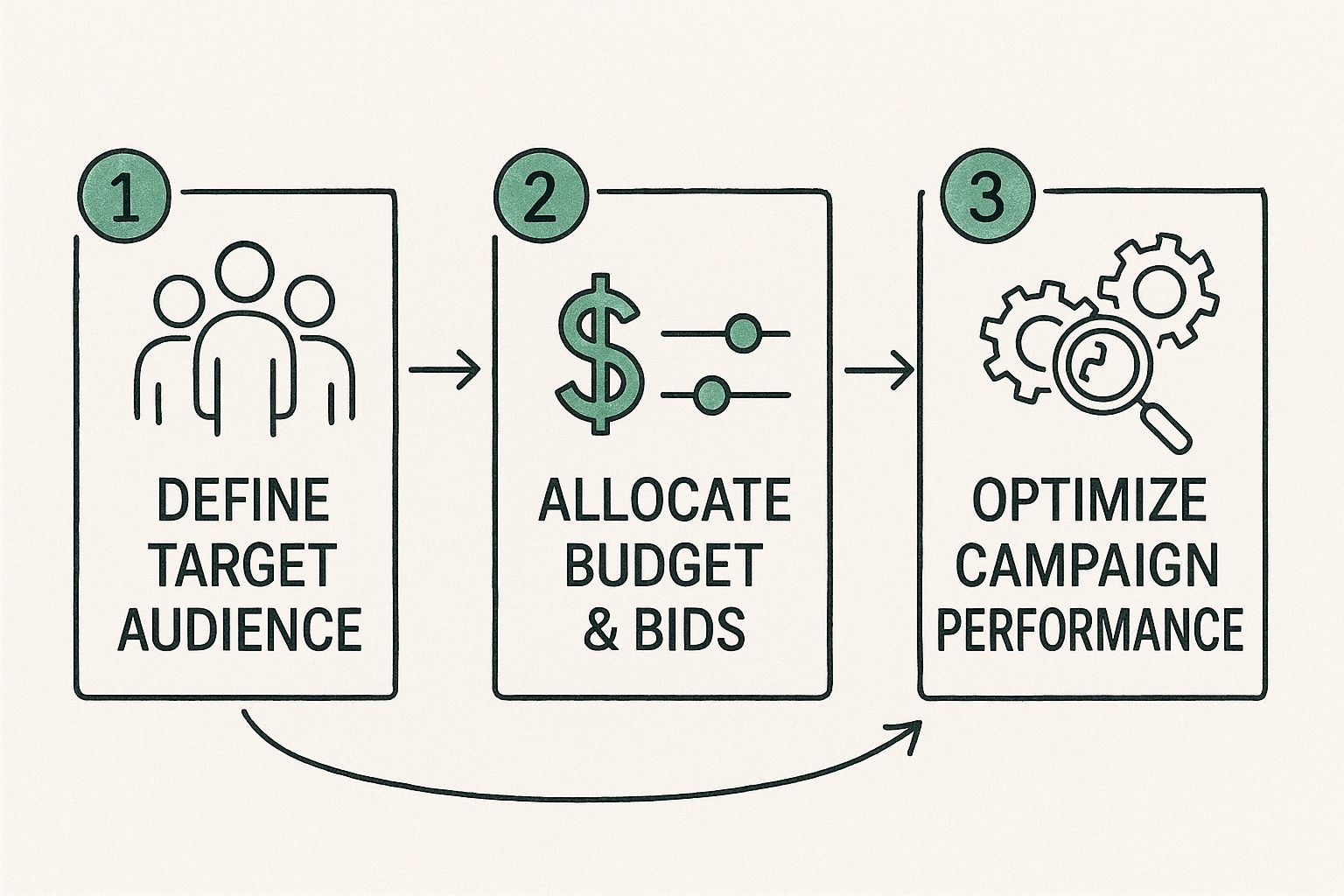
Each stage, from defining your audience to optimizing performance, builds on the last, making sure your budget is spent as efficiently as possible.
Setting Budgets and Avoiding Common Pitfalls
One of the biggest mistakes I see startups make is spreading their budget too thin across too many campaigns. Or they set it so low that the algorithm never gets enough data to learn and optimize. It’s always better to properly fund one or two highly targeted campaigns than to run five underfunded ones that go nowhere.
Your ad budget isn't an expense; it's an investment in data. Start small, figure out what works, and then confidently scale your spending on the campaigns that deliver real results.
Here are a few practical tips to get you started on the right foot:
- Start with a Test Budget: Earmark a specific, manageable amount for the first month—say, $500 to $1,500—purely for testing. Your goal isn't a massive ROI on day one. It's to gather data on which audiences, ad copy, and offers are hitting the mark.
- Target Precisely, but Not Too Narrowly: LinkedIn’s targeting is incredibly powerful, but if you make your audience too small (like under 1,000 people), your ads might not even get delivered. Aim for a well-defined but reasonably sized audience to give your campaigns room to breathe.
- Write Copy That Solves a Problem: Your ad copy shouldn't just be a list of features. It needs to speak directly to a pain point your target audience is feeling and position your solution as the obvious answer. Lead with their problem, then introduce your solution.
By thoughtfully combining a consistent organic rhythm with precise, data-driven paid campaigns, you’ll build a complete LinkedIn B2B marketing engine that not only grows your brand but actively pulls qualified leads right into your pipeline.
Measuring Success and Optimizing for Results

Executing a brilliant strategy is only half the battle. The real magic happens when you start listening to what the data is telling you.
Measuring your LinkedIn B2B marketing isn’t about chasing vanity metrics like likes or follower counts. It’s about understanding what actually drives business growth and having the courage to double down on what works—and ruthlessly cut what doesn’t.
This is where your strategy becomes a living, breathing thing. By digging past the surface-level numbers, you connect your LinkedIn activities directly to tangible business outcomes. This not only proves the channel's value but helps you constantly refine your approach for even better results.
The goal isn't just to have a popular social media page; it's to build a predictable engine for growth.
Identifying KPIs That Actually Matter
For B2B tech and SaaS companies, the only metrics that count are the ones signaling genuine buyer intent. These are the key performance indicators (KPIs) that tell a story about how your audience is moving from a passive observer to an active lead.
So, let's forget about getting bogged down by engagement rate alone. Instead, anchor your analysis to the numbers that have a clear, undeniable connection to your sales pipeline.
- Website Click-Through Rate (CTR): This is your gut check. Is your content compelling enough to pull someone off LinkedIn and onto your home turf?
- Lead Form Completions: If you're using LinkedIn’s Lead Gen Forms, this is your most direct measure of lead acquisition success. No ambiguity here.
- Cost Per Lead (CPL): For any paid campaigns, this is crucial. It tells you exactly how efficient your ad spend is and keeps your budget honest.
- Quality of Inbound Inquiries: Don't just count the number of DMs or contact requests—track the quality. Are they from your ideal customer profile? This qualitative data is pure gold.
The ultimate measure of success on LinkedIn isn't how many people see your content, but how many of the right people take meaningful action because of it.
Using LinkedIn Analytics to Your Advantage
LinkedIn’s native analytics tools are surprisingly powerful for uncovering insights that can—and should—guide your entire strategy.
Making a habit of diving into this data helps you understand who your audience is, what content actually resonates with them, and how your page is performing over time. This platform isn't just a place to post; it's a source of incredible market intelligence.
There's a reason B2B marketers are investing so heavily here. Projections show that LinkedIn's global B2B display ad revenue will approach $4.73 billion by the end of 2025. That kind of growth is fueled by data-driven strategies that you can implement, too. You can find more details on these financial trends over at Statista.
A Framework for Continuous Improvement
Data is completely useless without a process for acting on it. I’ve found that a simple monthly performance review can transform your approach from reactive to proactive, ensuring your LinkedIn B2B marketing strategy is always getting smarter.
Set aside a couple of hours each month to analyze your key metrics and answer a few critical questions.
For a more structured approach to measurement, our guide on using B2B marketing analytics for growth provides a much deeper framework.
During your review, ask yourself and your team:
- What was our absolute best-performing content? Look at clicks, comments, and lead form completions. What topics, formats, or hooks drove the best results? Get specific.
- How can we replicate that success? Let's brainstorm ways to create similar content or maybe repurpose those high-performers into different formats.
- What content completely missed the mark? Be brutally honest about what fell flat. Was the topic wrong for our audience? Was the format unengaging?
- What adjustments will we make next month? Based on your findings, create clear, actionable steps for the upcoming month’s content calendar and ad campaigns.
Answering Your Toughest B2B LinkedIn Marketing Questions
When I talk to SaaS and tech founders about their LinkedIn strategy, the same handful of questions pop up again and again. These aren’t just tactical queries; they get right to the heart of what it takes to build a marketing engine that feels sustainable and actually moves the needle.
Let's break down the most common hurdles I see marketers face. Getting these right is the difference between spinning your wheels and building real momentum.
How Often Should a B2B Company Post on LinkedIn?
This is the classic quality vs. quantity debate, and I land firmly on one side: consistency beats frequency every single time. Firing off ten low-effort posts a week is a surefire way to burn out your audience, not build it. You’ll just get lost in the noise.
Instead, a great starting point is 3-5 high-quality posts per week.
This cadence is just right—it’s frequent enough to stay on the algorithm’s good side and keep your brand visible, but it's also manageable enough that you won't have to sacrifice quality just to hit a number.
The best posting schedule is the one you can stick to while delivering genuine value in every post. If you can only manage three truly insightful posts a week, that’s infinitely better than five mediocre ones.
Focus your energy on making each post count. A single, well-crafted piece that sparks a real conversation is worth more than a dozen generic updates that get scrolled past. This approach respects your audience's time and builds your authority much faster.
What Is a Realistic Ad Budget for a Startup?
Jumping into LinkedIn Ads without a clear budget is like burning cash. For a B2B tech startup just dipping its toes in the water, a realistic starting point is somewhere between $500 and $1,500 for the first month.
But here's the crucial mindset shift: don't think of this initial budget as an investment in leads. It’s an investment in data.
The goal isn't to hit a home-run ROI on day one. It's to learn. You want to find out which audiences, ad creatives, and messaging hooks actually connect with your ideal customers.
Here’s a simple way to approach that first month:
- Go deep, not wide. Allocate your budget to just one or two highly targeted campaigns.
- Have a single goal. Focus on a clear, simple action, like downloading an ebook or signing up for a webinar.
- Analyze everything. At the end of the month, dig into the results to see what worked and what flopped. This data is your roadmap for what to do next.
Once you have this initial intel, you can start scaling up the campaigns that are proven winners, ensuring every dollar from then on is spent as effectively as possible. And if you want to get more creative with your ad visuals, there are some fantastic best AI tools for creating LinkedIn B2B infographics and other assets that can help you stand out.
How Can I Encourage My Team to Be Active on LinkedIn?
Your team is your single greatest untapped marketing asset. But here’s the truth: you can’t just tell them to "be more active on LinkedIn." Employee advocacy has to be encouraged, not forced. The trick is to make it incredibly easy and genuinely beneficial for them.
First, remove all the friction. Create something like a monthly "brag sheet" with links to the company's best content and even some suggested comments they can tweak and make their own. This simple step eliminates that "what am I supposed to say?" paralysis.
Next, frame it as a win for them, not just for the company. Show your team how building a personal brand on LinkedIn helps their career. It establishes them as experts in their field and helps them grow a professional network that will benefit them for years to come. When it becomes part of their own professional development, it stops feeling like a corporate chore.
Ready to turn your LinkedIn strategy into a predictable engine for growth? At Big Moves Marketing, I help B2B SaaS and AI startups build the positioning and launch strategies that drive revenue. Let's connect and discuss how we can make your next big move. https://www.bigmoves.marketing
%20-%20Alternate.svg)
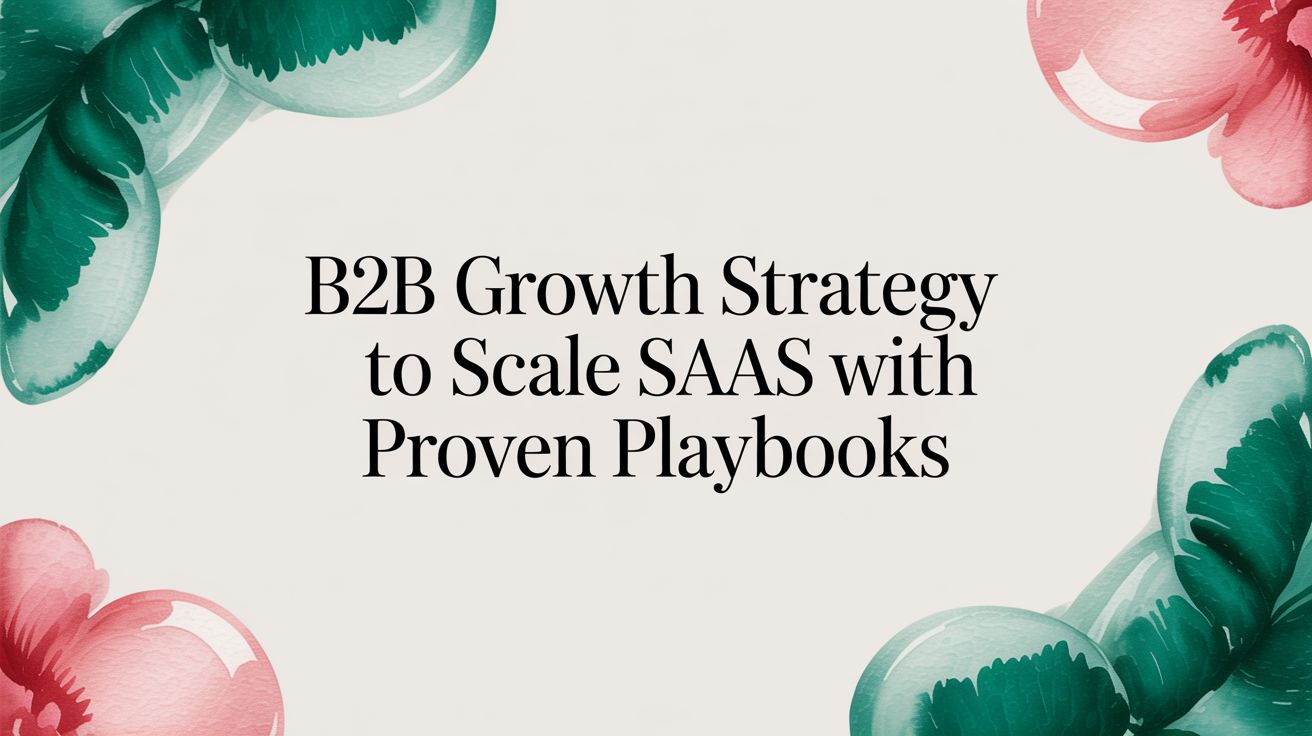
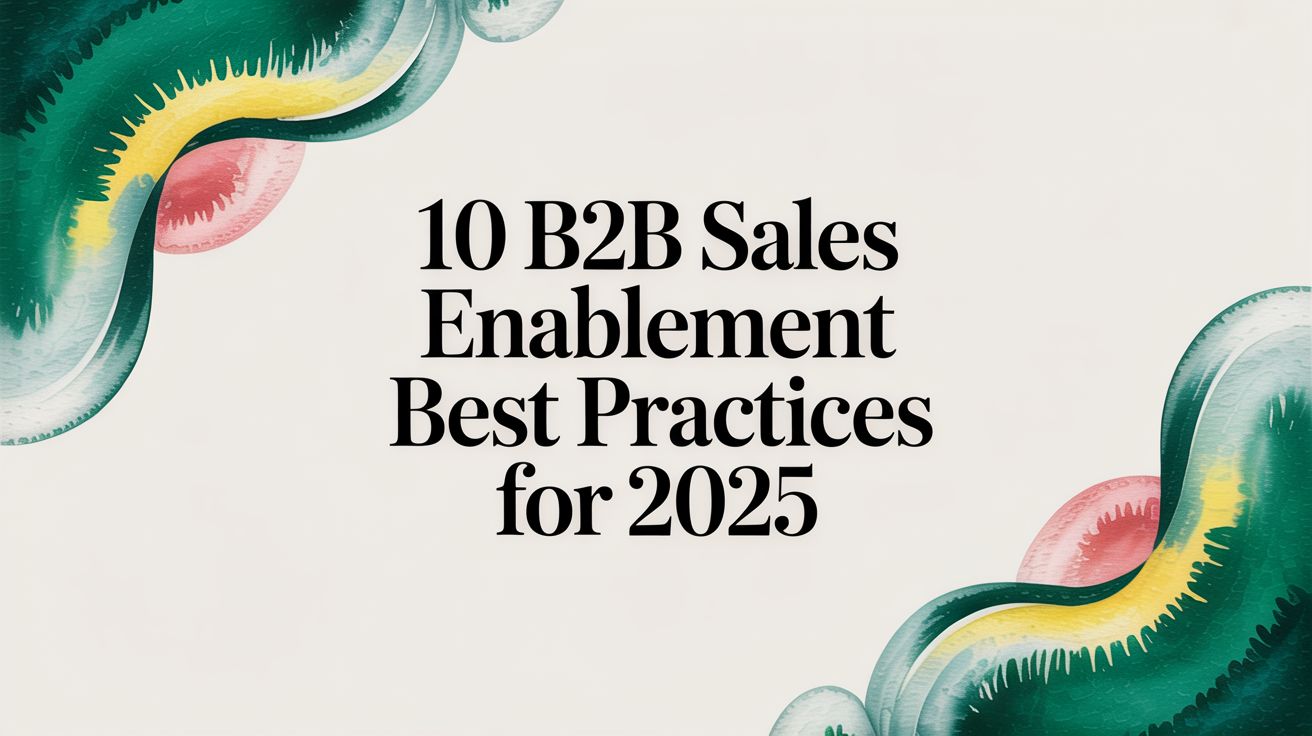
%20-%20white.svg)